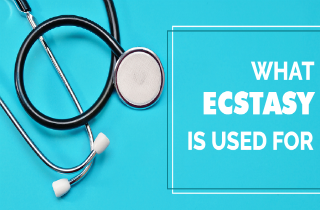Ecstasy, or Molly, are street names for MDMA (3,4-methylenedioxy-methamphetamine), a synthetic, psychoactive drug known for its stimulant and hallucinogen effects. It is an illegal, potentially addictive drug, and its use can cause long-term effects on the brain. But what are the primary uses for ecstasy? Does ecstasy work for everyone? We review here, and invite your questions about ecstasy and its use or symptoms of ecstasy addiction at the end.
What is ecstasy?
MDMA is an illegal drug that acts as both a stimulant and psychoactive drug that has similarities to both the stimulant amphetamine and the hallucinogen mescaline. Ecstasy has an energizing effect on the central nervous system, and can trigger distortions in time and perception as well as enhanced enjoyment from tactile experiences. Since MDMA is a man-made drug, manufacturers can add anything to the drug – such as caffeine, dextromethorphan, amphetamines, PCP, or cocaine- so its purity is always questionable.
History of the use of ecstasy
Originally, ecstasy was developed and patented as an appetite suppressant. In the U.S. it was used as a possible aid to psychotherapy, but was used without the support of clinical trial research or FDA approval. Later on, in 1985, the Drug Enforcement Administration labeled MDMA a Schedule I substance, or a drug with high abuse potential and no recognized medicinal use. But, there are still a lot of researchers who are interested in the potential therapeutic value of the drug, and currently clinical trials are looking into it as a possible pharmacotherapy aid to treat post-traumatic stress disorder (PTSD) and anxiety in terminal cancer patients.
Ecstasy use and side effects
The typical use of MDMA is oral, usually in a tablet, pill or capsule, and ecstasy effects last approximately 3 to 6 hours. Most users take a second dose of the drug as the effects of the first dose begin to fade. The short-term effects are a combination of positive and negative experiences, manifested during and after the drug wears off. Common side effects of ecstasy include:
- blood pressure increases
- blurred vision
- chills
- day-after depression
- dehydration
- distorts time and perception
- eye-twitching
- faintness
- headaches
- inability to regulate body temperature
- increases energy
- increases enjoyment from touching
- liver, kidney, and cardiovascular system problems
- muscle tension
- nausea
- perceptual changes, anxiety, jaw-clenching, dry mouth, and appetite changes
- seizures
- severe sweating
- sharp increase in body temperature, hyperthermia, heatstroke
The most common indicators of MDMA overdose are high blood pressure, faintness, panic attacks, loss of consciousness, or seizures. There also are very serious long term effect of the continuous use of ecstasy on overall health. These include:
Dramatic increases in heart rate can lead to serious complications for people with cardiovascular diseases.
Dehydration can lead to liver and kidney failure.
Disturbing emotional reactions can develop into confusion, depression, sleep problems, drug craving, and/or severe anxiety.
Since it effects the brain which is directly related to amount and frequency of usage, ecstasy can deplete the amount of serotonin in the brain and block the uptake, cause serious brain damage, or trigger memory loss.
Illegal ecstasy use
Ecstasy is used as recreational drug, among teenagers and young adults, often at all-night dance parties and night clubs. MDMA’s popularity has grown over the years due to its positive effects within the first hour after taking one dose. Some of those effects include: mental stimulation, emotional warmth, a sense of well-being, empathy, and decrease in anxiety. One of the most recognizable effects of the MDMA experience is the enhanced sensory perception. However, ecstsay is illegal to use in the U.S. and can lead to legal or judicial problems.
Problems using ecstasy
Ecstasy has been proven to affect many of the same neurotransmitter systems in the brain as other addictive drugs. Even though research on MDMA’s addictive properties has shown varying results, it can be highly addictive, and has serious consequences. At any rate, some users show significant symptoms of dependence, which includes continuous use of the drug despite harmful physical or psychological effects.
Currently, there are no pharmacological treatments for ecstasy abuse. The most effective solutions for dealing with the drug abuse problem include cognitive-behavioral interventions which are designed to affect and modify a person’s thinking, beliefs, and expectations, as well as addressing behaviors. Therapy aims to teach a person how to deal with stressors and everyday problems WITHOUT turning to ecstasy. Also, drug abuse recovery support groups may be of assistance in combination with the behavioral interventions to assist and support the long-term, drug-free recovery.
Ecstasy use questions
Please let us know if you have other additional questions about ecstasy use, abuse, or treatment. We’ll be happy to respond to you personally. And we try to reply to all legitimate queries promptly.









Related Posts